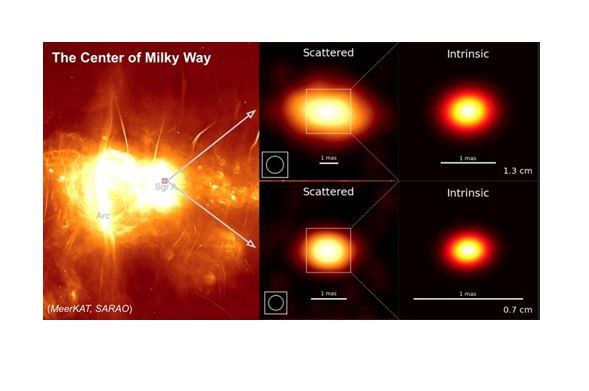Astronomers have found that underlying structure of the supermassive black hole at the center of Milky Way, named Sagittarius A* (Sgr A*), is almost circular from the East Asian VLBI Network (EAVN) observations at 1.3 cm and 7 mm wavelengths. Its size may indicate the accretion flow around the Sgr A* contains the nonthermal electrons, and the shape tells us the accretion flow’s rotation axis (or a possible radio jet) may be almost pointing at the Earth.

(Left: Galactic Center region from MeerKAT and SARAO. Right: The results from EAVN observations at 1.3 cm (top) and 7 mm (bottom). The scattered structures are on the left-hand side, and the scattering mitigated intrinsic structures of Sgr A* are shown on the right-hand side.)
Sgr A* is the best target to investigate what happens around a black hole, since it is the closest supermassive black hole from the Earth. In 2020, the Nobel Prize in Physics has also awarded to the studies of Sgr A*. To resolve the fine structure of Sgr A*, astronomers have used the very long baseline interferometry (VLBI) technique which consists of many radio telescopes at different geographic locations so that it makes a virtual telescope the size of the distance between telescopes. Toward Sgr A*, however, there is another challenge which is the light scattering by the gas clouds in our Galaxy. To overcome this issue, Dr. Cho of Instituto de Astrofisica de Andalucia (IAA-CSIC) and the international team applied the scattering model from recent studies based on the historical observations to their observations with the East Asian VLBI Network (EAVN). As a result, the team has found that the intrinsic structure of Sgr A* is almost circular at 1.3 cm and 7 mm wavelengths. “Before correcting the effect of interstellar scattering medium, the structure of Sgr A* is more elongated towards the East-West direction. Through our study, we show that the elongation is mostly coming from the scattering effect”, explains Dr. Cho of IAA-CSIC who has led this work confirmed it with three different methods independently.
The EAVN consists of 21 radio telescopes: 11 in Japan, 4 in Korea, and 6 in China. For this study, 10 and 8 of them have been used to observe at 1.3 cm and 7 mm wavelengths, respectively. The observations were conducted in 2017 April, as a part of the large program of the Active Galactic Nuclei (AGN) Science Working Group under the EAVN consortium. In addition, they are a part of the multi-wavelength campaign of the Event Horizon Telescope (EHT) which has unveiled the image of black hole shadow for the first time ever from the M87*. Dr. Kino of Kogakuin University of Technology and Engineering (KUTE-Tokyo) who leads EAVN AGN Science Working Group says, “After years of our dedicated efforts, the EAVN is now up and running, and we have now obtained the important scientific results on Sgr A* that take advantage of the benefits of the EAVN. The EAVN enabled us to make it all.”
(The radio telescopes of East Asian VLBI Network, which participated in the observations in 2017.)
Compared with the theoretical simulation of an accretion flow, the circular shape of Sgr A* may imply that the rotation axis of the accretion flow is almost pointing at us. In addition, the size of Sgr A* implies that the accretion flow around the supermassive black hole has to contain the nonthermal electrons.
Dr. Kawashima of Institute for Cosmic Ray Research (ICRR) University of Tokyo, who is in charge of numerical simulations, says “Only with the thermal electrons, the predicted size is much smaller than the observed value. We found that this size-mismatch problem can be solved by including nonthermal electron components”.
Together with the result at 3 mm by Dr. Issaoun and the colleagues, the relation of the Sgr A*’s size and brightness and observing wavelength have been found. This is the first analysis with the VLBI data within a 2 days timescale. Assuming the same relation at shorter wavelengths, the size & brightness of the Sgr A* at 1.3 mm wavelength (230 GHz frequency) is predicted. Dr. Zhao of IAA-CSIC, one of the coordinators of the EHT scattering working group, says “This could be of great help to the EHT 2017 data analysis aiming to make the first image of the black hole shadow of Sgr A*.”
There is a long-standing debate on the dominant radio emission scenario for Sgr A*, whether an accretion flow or a jet. This study has improved the accretion flow model prediction, but the jet scenario is still available to explain the results. To constrain the possible scenarios, future studies will be of great importance such as the long-term monitoring observations with multiple wavelength receivers of EAVN. This will provide the finer structure of Sgr A* and accurate position of the radio emission region at different wavelengths so that the possibility of each emission model can be further narrowed down.
These results were published as Cho et al. in the Astrophysical Journal
URL: https://iopscience.iop.org/article/10.3847/1538-4357/ac4165
on February 22, 2022.
Title: The Intrinsic Structure of Sagittarius A* at 1.3 cm and 7 mm
Authors: Ilje Cho, Guang-Yao Zhao, Tomohisa Kawashima, Motoki Kino, Kazunori Akiyama, Michael D. Johnson, Sara Issaoun, Kotaro Moriyama, Xiaopeng Cheng, Juan-Carlos Algaba et al.
DOI: 10.3847/1538-4357/ac4165
■About KOGAKUIN University
Kogakuin University was initially founded in 1887. It was the first private engineering school established in Japan to train engineers who would work on the front lines of the industries that were needed for promoting Japan’s modernization. Its graduates are particularly active in the fields of engineering and architecture.
Kogakuin University has several research institutes, supported by financial assistance from the Ministry of Education, Culture, Sports, Science and Technology, and encourages joint research with corporate partners. https://www.kogakuin.ac.jp/english/about/message.html



